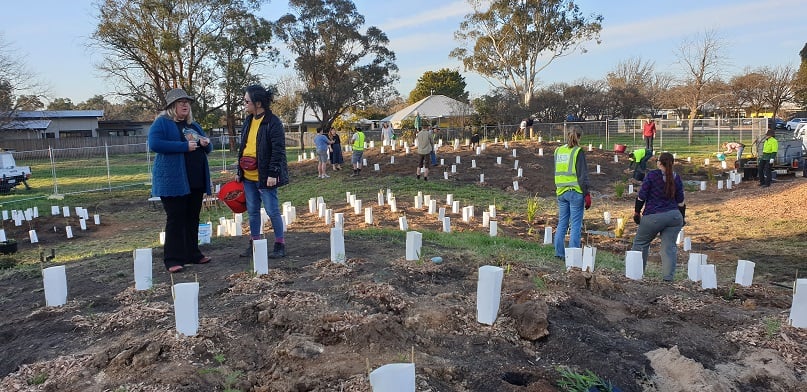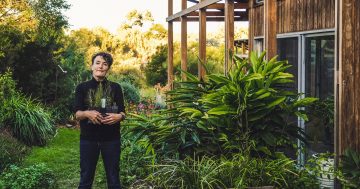
Community members with trees in the ground for the micro-forest at Downer. Photo: Supplied.
A good-natured suburban rivalry is brewing between two community-led micro-forests in Canberra’s inner north, where nature is the winner and children are having a say on their future.
Now that the first crowd-funded micro-forest at Downer is growing, a second one at Watson has also taken root with more than 1500 native plants, a forest classroom for outdoor learning, indigenous bushfood and an integrated nature playscape.
The project has also harnessed the power of the suburbs, with young minds creating art projects to help shape the design of the urban sanctuary at Watson.
Like the Downer micro-forest at the Cole Street park in Downer, which was the brainchild of Edwina Robinson’s social enterprise, The Climate Factory, the Watson micro-forest in Wade Street is a community-led project to create an urban oasis that combats climate change, strengthens the community and re-connects people with nature.
The project has raised almost $53,000 through a crowd-funding campaign and aims to secure supplementary funding through ACT Government grants.
Project co-leads Liz Adcock and Purdie Bowden also hope the Watson micro-forest will inspire similar projects and are working with government, business and community groups to make this easier for volunteers like themselves.
Liz and Purdie have also been inundated with support. They have just partnered with YWCA Canberra and some of the youngest members of the community, who have taken part in an art competition at Majura Primary School to inspire the design of an urban sanctuary for the Watson micro-forest.

Downer micro-forest coordinator Edwina Robinson, Environment Minister Rebecca Vassarotti with Watson micro-forest coordinators Liz Adcock and Purdie Bowden holding some of the art competition entries. Photo: Supplied.
Ms Adcock said she wanted children to be the focus of the project at Watson, while the hall at Majura Primary School saw lots of creative entries in the theme ‘Micro-forests: imagine what could be!’
“I want kids to have a voice in their community,” Ms Adcock said. “They are the ultimate users of the space, so their views, experiences and suggestions are important. We have to understand their needs.
“We want the micro-forest to help kids understand the challenges of combating climate change and protecting biodiversity while also empowering them to do something about it.”
The Watson Micro-forest team has also held workshops with students at Majura Pre-School, where the young students used playdough and natural materials to create their own micro-forest.
“Kids are naturally creative. When adults make an effort to include children in the design, they can make a genuine contribution to the project and do so much learning along the way,” Ms Adcock said.
“We hope kids from Watson and surrounds will come to use and love the micro-forest and that its outdoor classroom and nature playscape will provide a space for play and learning for generations to come.”
Environment Minister Rebecca Vassarotti said she was excited to see people taking action to improve their local environment.
“I am thrilled to see so many Canberrans, young and old, getting involved in environmental action and using their creativity to inspire how we combat climate change and protect our precious biodiversity,” Ms Vassarotti said.
“I want to thank everyone for submitting their wonderful art projects and encouraging us all to connect, love and care for our beautiful environment.”
Members of the community wanting to find out more can also attend the Watson micro-forest’s first workshop, facilitated by Liesl Codrington, on Wednesday, 31 March, from 6:30 pm to 8:30 pm at the Australian Technology Park, Phillip Ave, Watson.














